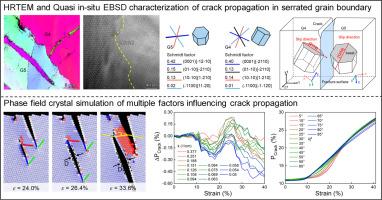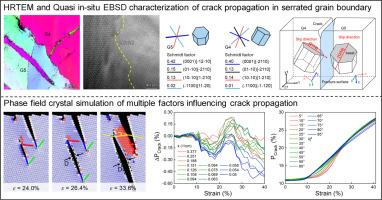纯镁中锯齿晶界调制抑制纳米裂纹扩展:相场晶体和准原位EBSD研究
IF 9.3
1区 材料科学
Q1 MATERIALS SCIENCE, MULTIDISCIPLINARY
引用次数: 0
摘要
调制锯齿晶界(SGB)具有提高材料断裂性能的潜力。本文通过高分辨率透射电镜、准原位电子背散射衍射和相场晶体模拟研究了SGB在加载过程中的裂纹行为。实验结果表明,纳米裂纹的萌生和扩展是由不同晶间角度的基滑移或棱柱滑移驱动的。此外,在SGB弯曲区域观察到较大的剪切应变,并且这些区域中与加载方向对齐的部分阻碍了裂纹的扩展。以往的研究表明,垂直于晶界的加载方向促进了晶间断裂。然而,我们的研究表明,GB与加载方向夹角对裂纹扩展的影响是局部的,之前的结论仅在10-27%的应变范围内有效。在此临界应变之外,裂纹主要以脆性方式穿晶扩展,在加载方向上的影响较弱。此外,当SGB与加载方向夹角小于65°时,平行于加载方向的SGB比例增加,从而抑制了晶间断裂。此外,SGB曲率显著影响裂纹扩展,双锯齿晶界的最佳曲率约为0.151 1/nm,可有效抑制纳米裂纹扩展。采用几何相容系数量化了SGB弯道处Lommer-Cottrell锁对裂纹扩展的阻碍作用。这项工作可能为通过控制SGB来提高材料断裂强度提供见解。本文章由计算机程序翻译,如有差异,请以英文原文为准。


Serrated grain boundary modulation inhibits nano cracks propagation in pure magnesium: A phase field crystal and quasi in-situ EBSD study
Modulating serrated grain boundaries (SGB) has the potential to enhance fracture properties in materials. This work investigates the crack behavior at SGB during loading through high-resolution transmission electron microscopy, quasi in-situ electron backscatter diffraction and phase field crystal simulations. Experimental results demonstrate that nano-crack initiation and propagation at SGBs driven by basal or prismatic <a> slip at varying angles between grains. Additionally, large shear strains are observed in the SGB bending regions, and portions of these regions that align with the loading direction impede crack propagation. Previous studies have suggested that a loading direction perpendicular to the grain boundary (GB) promotes intergranular fracture. However, our research demonstrates that the influence of the angle between GB and the loading direction on crack propagation is localized, with previous conclusions valid only within a strain range of 10-27%. Beyond this critical strain, cracks predominantly transgranular propagate in a brittle manner, with a weaker effect in the loading direction. Furthermore, when the angle between SGB and the loading direction is less than 65°, the proportion of the SGB parallel to the loading direction increases, thereby inhibiting intergranular fracture. Additionally, SGB curvature significantly impacts crack extension, with an optimal curvature of approximately 0.151 1/nm for double-serrated grain boundaries that effectively suppresses nano-crack propagation. The hindering effect of Lommer–Cottrell locks at the SGB bends on crack propagation is quantified by the geometric compatibility factor. This work may provide insights into enhancing material fracture strength through the control of SGB.
求助全文
通过发布文献求助,成功后即可免费获取论文全文。
去求助
来源期刊

Acta Materialia
工程技术-材料科学:综合
CiteScore
16.10
自引率
8.50%
发文量
801
审稿时长
53 days
期刊介绍:
Acta Materialia serves as a platform for publishing full-length, original papers and commissioned overviews that contribute to a profound understanding of the correlation between the processing, structure, and properties of inorganic materials. The journal seeks papers with high impact potential or those that significantly propel the field forward. The scope includes the atomic and molecular arrangements, chemical and electronic structures, and microstructure of materials, focusing on their mechanical or functional behavior across all length scales, including nanostructures.
 求助内容:
求助内容: 应助结果提醒方式:
应助结果提醒方式:


